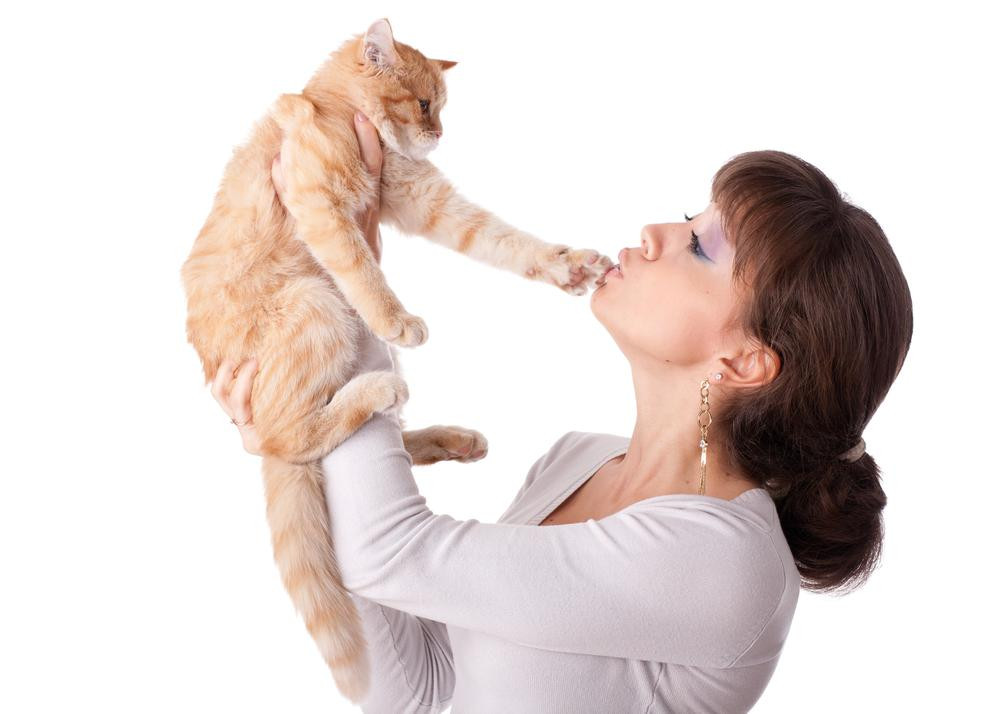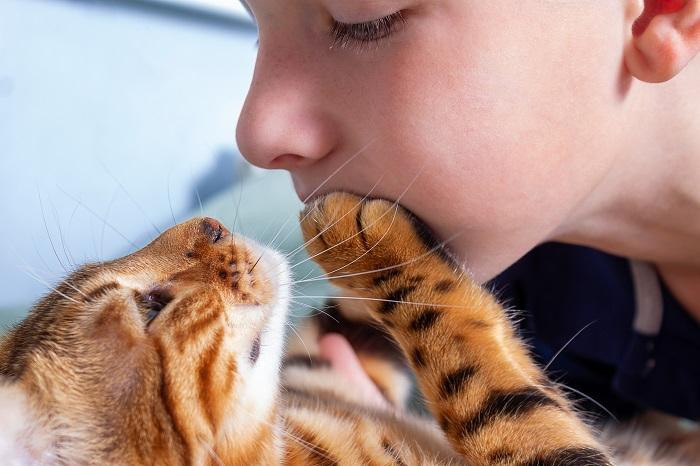Does your cat gently place a paw on your face, leaving you curious about the reason behind this adorable behavior? At solcat.net, we’re here to unravel the mysteries of feline communication, helping you understand your furry friend better. Discover the various reasons behind this seemingly sweet gesture and gain insights into your cat’s world, including their unique ways of showing affection, marking territory, and seeking attention.
1. Is It Affection? The Loving Touch Explained
Is your cat showing love when they touch your face? Yes, often it is! If your cat is snuggling close, purring contentedly, and gently placing a paw on your face with retracted claws, it’s highly likely they’re expressing affection. This behavior often occurs when they’re relaxed and feel safe and secure with you. Slow blinks are an additional sign of comfort and trust.
Cats show affection in many ways. According to the American Animal Hospital Association (AAHA), cats might also rub against you, purr, or knead on your lap to demonstrate their love. Observing your cat’s overall body language can provide further insight into their emotional state. Is their tail held high? Are they relaxed and content? These are all positive signs.
 Gray cat sleeping on a woman's chest.
Gray cat sleeping on a woman's chest.
2. Scent Marking: Claiming You as Their Own
Why do cats leave their scent on you? Your cat might be scent marking you. Cat paws contain scent glands that release pheromones, chemical signals used for communication. By placing their paws on your face, cats deposit these pheromones, essentially marking you as part of their family and territory. This behavior is a natural way for cats to create a sense of belonging and security within their environment.
According to the Cornell Feline Health Center, scent marking is a common behavior in cats, used to establish territory and communicate with other cats. This can also involve rubbing their cheeks or body against objects or people. Your cat’s scent is their signature, and by sharing it with you, they’re strengthening your bond.
3. Stretching: A Sign of Comfort and Trust
Is your cat comfortable enough to stretch around you? When cats stretch, they often extend their paws, which might land on your face. This is usually unintentional but indicates they feel relaxed and secure enough to stretch out fully in your presence.
Stretching is a natural feline behavior that helps maintain flexibility and improves circulation. It also indicates a sense of trust, as cats are vulnerable when stretching. If your cat feels safe enough to stretch near you, it’s a sign they trust you and feel comfortable in your presence.
4. Seeking Attention: “Hey, Look at Me!”
Is your cat seeking your attention by touching your face? Paws on the face are hard to ignore! If your cat wants food, playtime, or simply some one-on-one attention, they may gently paw at your face to get your attention.
Cats are intelligent creatures and quickly learn what behaviors elicit a response from their humans. If pawing at your face has resulted in attention in the past, they’re likely to repeat the behavior. Pay attention to other cues, such as meowing or purring, to understand what your cat wants.
 Cute kitten sitting on a woman's shoulder.
Cute kitten sitting on a woman's shoulder.
5. Playful Paws: Initiating a Game
Is your cat trying to initiate playtime with you? Cats, especially kittens, can be quite playful. They may start pawing or swatting at your hands, feet, or face in an attempt to engage in play.
Playing is essential for a cat’s physical and mental well-being. It helps them burn energy, practice their hunting skills, and bond with their humans. While playful pawing is generally harmless, it’s important to redirect this behavior towards appropriate toys to avoid unwanted scratches or bites.
6. “Too Close!” When Space Is Needed
Is your cat’s paw a sign that you’re too close? Sometimes, a paw on the face means your cat wants space. They might be feeling overwhelmed or uncomfortable with your proximity.
Pay attention to your cat’s body language. If they’re hissing, growling, or have their ears back, it’s a clear sign they want you to back off. Respecting their need for space is crucial for maintaining a positive relationship with your feline friend.
7. Why Some Cats Don’t Touch Faces: Personality Matters
Why doesn’t your cat put their paws on your face? Not all cats exhibit this behavior. It often depends on their individual personality, socialization experiences, and current stress levels.
Some cats are naturally more affectionate and cuddly, while others are more independent. A cat’s early experiences, especially their interactions with humans as kittens, can also influence their behavior. A stressed or anxious cat may be less likely to initiate physical contact.
8. Discouraging Face Touching: Gentle Redirection Techniques
How can you stop your cat from putting their paws on your face if you don’t like it? While this behavior is usually harmless, it can be uncomfortable, especially if their claws are involved. You can’t completely stop a cat from doing what is natural, but you can redirect their attention.
Here are some tips:
- Trim your cat’s nails: This can help prevent scratches. However, don’t do this if your cat has outdoor access, as they need their nails for defense and climbing.
- Redirect their paws: Gently move their paws to a soft blanket or toy.
- Use pheromone sprays: Spray the blanket with a synthetic pheromone spray to encourage them to use it.
- Respect their space: If your cat seems stressed or upset, give them space.
 Cat with yellow eyes and white paws.
Cat with yellow eyes and white paws.
9. The Importance of Veterinary Checkups: Addressing Underlying Issues
Could there be an underlying health issue causing your cat to touch your face? If your cat’s behavior changes suddenly, it could indicate a health problem. Always consult with your veterinarian to rule out any underlying medical conditions.
According to the American Animal Hospital Association (AAHA), regular veterinary checkups are essential for maintaining your cat’s health and well-being. Your veterinarian can identify and address any potential health issues that may be affecting your cat’s behavior.
10. Solcat.net: Your Trusted Source for Feline Insights
Looking for more information and insights into the feline world? Visit solcat.net for reliable and up-to-date information on cat behavior, health, and care. Our resources are designed to help you understand your cat better and provide them with the best possible life.
At solcat.net, we understand the unique bond between humans and cats. We’re committed to providing you with the knowledge and resources you need to nurture that bond and create a happy and healthy life for your feline companion.
Here are some things you can find on solcat.net:
- Informative articles on cat behavior
- Tips on cat health and care
- A community forum for cat lovers
- Expert advice from veterinarians and cat behaviorists
Address: 950 Alaskan Way, Seattle, WA 98104, United States.
Phone: +1 (206) 386-4000
Website: solcat.net
Frequently Asked Questions (FAQ)
1. Why Does My Cat Put Their Paw on My Face?
Cats put their paws on your face for many reasons including showing affection, wanting to play, scent marking, or seeking attention. Observing their other behaviors will help to determine why.
2. Why Do Cats Touch Your Face with Their Nose?
Cats may touch your face with their nose as a way of showing affection, scent marking, smelling you, or simply being curious.
3. What if My Cat Doesn’t Put Their Paws on My Face?
If your cat doesn’t put their paws on your face, don’t worry! Cats are individuals with different personalities and ways of expressing affection. Your cat probably shows love in other ways, such as simply sitting next to you or purring.
4. Is it Okay to Let My Cat Sleep on My Face?
While some people enjoy the feeling of their cat sleeping on them, it’s generally not recommended to let your cat sleep on your face. This can disrupt your sleep and potentially pose a health risk if your cat carries any parasites or bacteria.
5. How Do I Redirect My Cat’s Attention Away From My Face?
You can gently redirect your cat’s attention by offering them a toy or treat. You can also try moving them to a more comfortable spot, such as their bed or a nearby cushion.
6. Can a Cat’s Paw on My Face Be a Sign of Anxiety?
In some cases, a cat putting their paw on your face can be a sign of anxiety. If your cat seems distressed or is exhibiting other signs of anxiety, such as hiding or excessive grooming, it’s important to consult with a veterinarian or cat behaviorist.
7. Is There a Difference Between a Cat Pawing and Kneading?
Yes, pawing and kneading are two different behaviors. Pawing is typically a gentle tapping or touching with the paws, while kneading involves rhythmically pushing their paws into a soft surface, often accompanied by purring.
8. Should I Be Concerned if My Cat’s Claws Are Out When They Touch My Face?
If your cat’s claws are out when they touch your face, it’s important to be cautious. This could be a sign that they’re feeling threatened or defensive. Avoid sudden movements and try to gently move away.
9. How Can I Encourage My Cat to Show Affection in Other Ways?
You can encourage your cat to show affection in other ways by spending quality time with them, playing with them, and providing them with plenty of love and attention. You can also try offering them treats or toys as a reward for positive behavior.
10. What Are Some Other Common Cat Behaviors and Their Meanings?
Some other common cat behaviors and their meanings include:
- Purring: Usually a sign of contentment, but can also indicate pain or stress.
- Hissing: A warning sign that they’re feeling threatened or defensive.
- Rubbing: Scent marking and showing affection.
- Kneading: Comfort and contentment, often associated with nursing.
- Tail twitching: Can indicate excitement, frustration, or agitation.
Understanding your cat’s behavior can help you build a stronger bond and provide them with the best possible care. For more information and resources, visit solcat.net today!
More From Cat Psychology
Cat Behavior
Why Do Cats Cover Their Food?
Cat Behavior
What the World Looks Like from a Cat’s Perspective
Cat Behavior
How Cold Is Too Cold for Cats?
Cat Behavior
Why Do Cats Bunny Kick? 3 Fascinating Reasons Behind This Behavior
